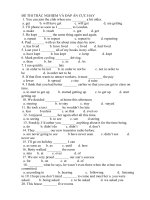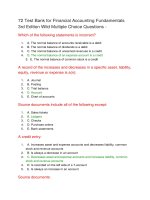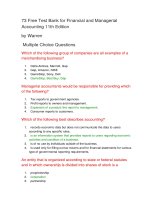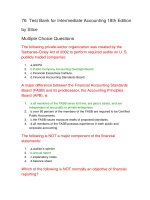74 test bank for accounting 24th edition đề trắc nghiệm có đáp án
Bạn đang xem bản rút gọn của tài liệu. Xem và tải ngay bản đầy đủ của tài liệu tại đây (91.21 KB, 20 trang )
74 Test Bank for Accounting 24th Edition
by Warren Multiple Choice Questions - Page 1
Which of the items below is not a business entity?
1.
entrepreneurship
2.
proprietorship
3.
partnership
4.
corporation
Which of the following group of companies are all examples of a
merchandising business?
1.
Delta Airlines, Marriott, Gap
2.
Gap, Amazon, NIKE
3.
GameStop, Sony, Dell
4.
GameStop, Best Buy, Gap
Equipment with an estimated market value of $55,000 is offered
for sale at $75,000. The equipment is acquired for $20,000 in
cash and a note payable of $40,000 due in 30 days. The amount
used in the buyer's accounting records to record this acquisition
is
1.
$55,000
2.
$60,000
3.
$20,000
4.
$75,000
Assets are
1.
always greater than liabilities.
2.
either cash or accounts receivables
3.
the same as expenses because they are acquired with cash
4.
financed by the owner and/or creditors
The business entity concept means that
1.
the owner is part of the business entity
2.
an entity is organized according to state or federal statutes
3.
an entity is organized according to the rules set by the FASB
4.
the entity is an individual economic unit for which data are recorded,
analyzed, and reported
Which of the following groups are considered to be internal users
of accounting information?
1.
Employees and customers
2.
Customers and vendors
3.
Employees and managers
4.
Government and banks
Which of the following is not a certification for accountants?
1.
CIA
2.
CMA
3.
CISA
4.
All are certifications.
Which of the following is a manufacturing business?
1.
Amazon.com.
2.
Wal-Mart.
3.
Ford Motors.
4.
Delta Airlines
The initials GAAP stand for
1.
General Accounting Procedures
2.
Generally Accepted Plans
3.
Generally Accepted Accounting Principles
4.
Generally Accepted Accounting Practices
Which of the following is not a role of accounting in business?
1.
2.
To provide reports to users about the economic activities and conditions of
a business.
To personally guarantee loans of the business.
3.
To provide information to other users to determine the economic
performance and condition of the business.
4.
To assess the various informational needs of users and design its
accounting system to meet those needs.
All of the following are general-purpose financial statements
except:
1.
balance sheet
2.
income statement
3.
statement of owner’s equity
4.
cash budget
On April 25, Gregg Repair Service extended an offer of $115,000
for land that had been priced for sale at $140,000. On May 3,
Gregg Repair Service accepted the seller’s counteroffer of
$127,000. On June 20, the land was assessed at a value of
$88,000 for property tax purposes. On August 4, Gregg Repair
Service was offered $150,000 for the land by a national retail
chain. At what value should the land be recorded in Gregg Repair
Service’s records?
1.
$115,000
2.
$88,000
3.
$140,000
4.
$127,000
An entity that is organized according to state or federal statutes
and in which ownership is divided into shares of stock is a
1.
proprietorship
2.
corporation
3.
partnership
4.
governmental unit
Select the type of business that is most likely to obtain large
amounts of resources by issuing stock.
1.
Partnership
2.
Corporation
3.
Proprietorship
4.
None are correct.
Financial reports are used by
1.
management
2.
creditors
3.
investors
4.
all are correct
Which of the following concepts relates to separating the
reporting of business and personal economic transactions?
1.
Cost Concept
2.
Unit of Measure Concept
3.
Business Entity Concept
4.
Objectivity Concept
Which of the following is true in regards to a Limited Liability
Company?
1.
Makes up 10% of business organizations in the United States.
2.
Combines the attributes of a partnership and a corporation.
3.
Provides tax and liability advantages to the owners.
4.
All are correct.
For accounting purposes, the business entity should be
considered separate from its owners if the entity is
1.
a corporation
2.
a proprietorship
3.
a partnership
4.
all of the above
Debts owed by a business are referred to as
1.
accounts receivables
2.
equities
3.
owner’s equity
4.
liabilities
Most businesses in the United States are
1.
proprietorships
2.
partnerships
3.
corporations
4.
separate entities
Managerial accountants would be responsible for providing the
following information:
1.
Tax reports to government agencies.
2.
Profit reports to owners and management.
3.
Expansion of a product line report to management.
4.
Consumer reports to customers.
The following are examples of external users of accounting
information except:
1.
government
2.
customers
3.
creditors
4.
all of the above
Which of the following is the best description of accounting’s role
in business?
1.
Accounting provides stockholders with information regarding the market
value of the company’s stocks.
2.
Accounting provides information to managers to operate the business and
to other users to make decisions regarding the economic condition of the
company.
3.
Accounting provides creditors and banks with information regarding the
credit risk rating of the company.
4.
Accounting is not responsible for providing any form of information to users.
That is the role of the Information Systems Department.
Which of the following would not normally operate as a service
business?
1.
Pet Groomers
2.
Restaurant
3.
Lawn Care Company
4.
Styling Salon
Which one of the following is the authoritative body in the United
States having the primary responsibility for developing accounting
principles?
1.
FASB
2.
IRS
3.
SEC
4.
AICPA
Which of the following is not a characteristic of a corporation?
1.
Corporations are organized as a separate legal taxable entity
2.
Ownership is divided into shares of stock.
3.
Corporations experience an ease in obtaining large amounts of resources
by issuing stock.
4.
A corporation’s resources are limited to their individual owners’ resources.
The objectivity concept requires that
1.
business transactions must be consistent with the objectives of the entity
2.
the Financial Accounting Standards Board must be fair and unbiased in its
deliberations over new accounting standards
3.
accounting principles must meet the objectives of the Security and
Exchange Commission
4.
amounts recorded in the financial statements must be based on
independently verifiable evidence
Which type of accountant typically practices as an individual or as
a member of a public accounting firm?
1.
Certified Public Accountant
2.
Certified Payroll Professional
3.
Certified Internal Auditor
4.
Certified Management Accountant
Which of the following best describes accounting?
1.
records economic data but does not communicate the data to users
according to any specific rules.
2.
is an information system that provides reports to users regarding economic
activities and condition of a business.
3.
4.
is of no use by individuals outside of the business.
is used only for filling out tax returns and for financial statements for various
type of governmental reporting requirements.
Two common areas of accounting that respectively provide
information to internal and external users are:
1.
forensic accounting and financial accounting
2.
managerial accounting and financial accounting
3.
managerial accounting and environmental accounting
4.
financial accounting and tax accounting systems
Donner Company is selling a piece of land adjacent to their
business. An appraisal reported the market value of the land to be
$120,000. The Focus Company initially offered to buy the land for
$107,000. The companies settled on a purchase price of
$115,000. On the same day, another piece of land on the same
block sold for $122,000. Under the cost concept, what is the
amount that will be used to record this transaction in the
accounting records?
1.
$107,000
2.
$115,000
3.
$120,000
4.
$122,000
Denzel Jones owns and operates Crystal Cleaning Company.
Recently, Denzel withdrew $18,000 from Crystal Cleaning, and he
contributed $14,000, in his name, to Habitat for Humanity. The
contribution of the $14,000 should be recorded on the accounting
records of which of the following entities?
1.
Crystal Cleaning and Habitat for Humanity
2.
Denzel Jones' personal records and Habitat for Humanity
3.
Denzel Jones’ personal records and Crystal Cleaning
4.
Denzel Jones’ personal records, Crystal Cleaning, and Habitat for Humanity
Which of the following is not true of accounting principles?
1.
Financial accountants follow generally accepted accounting principles
(GAAP).
2.
Following GAAP allows accounting information users to compare one
company to another.
3.
4.
A new accounting principle can be adopted with stockholders approval.
The Financial Accounting Standards Board (FASB) has primary
responsibility for developing accounting principles.
Due to various fraudulent business practices and accounting
coverups in the early 2000’s, Congress enacted the SarbanesOxley Act of 2002. The Act was responsible for establishing a
new oversight board for public accountants called the
1.
Generally Accepted Accounting Practices for Public Accountants Board.
2.
Public Company Accounting Oversight Board.
3.
Congressional Accounting Oversight Board.
4.
None are correct.
Within the United States, the dominant body in the primary
development of accounting principles is the
1.
American Institute of Certified Public Accountants (AICPA)
2.
American Accounting Association (AAA)
3.
Financial Accounting Standards Board (FASB)
4.
Institute of Management Accountants (IMA)
Which of the following are guidelines for behaving ethically?
I.Identify the consequences of a decision and its effect on others;
II.Consider your obligations and responsibilities to those affected
by the decision; III.Identify your decision based on personal
standards of honesty and fairness.
1.
I and II.
2.
II and III.
3.
I and III.
4.
I, II, and III.
The Sarbanes-Oxley Act of 2002 prohibits employment of
auditors by their clients for what period after their last audit of the
client?
1.
Indefinitely
2.
One year
3.
Two years
4.
There is no such prohibition.
74 Free Test Bank for Accounting 24th Edition by
Warren Multiple Choice Questions - Page 2
A financial statement user would determine if a company was
profitable or not during a specific period of time by reviewing
1.
the Income Statement.
2.
the Balance Sheet.
3.
the Statement of Cash Flows.
4.
cannot be determined.
The year-end balance of the owner's capital account appears in
1.
both the statement of owner's equity and the income statement
2.
only the statement of owner's equity
3.
both the statement of owner's equity and the balance sheet
4.
both the statement of owner's equity and the statement of cash flows
Clifford Moore is starting his computer programming business and
has deposited in initial investment of $15,000 into the business
cash account. Identify how the accounting equation will be
affected.
1.
Increase Assets (Cash) and increase Liabilities (Accounts Payable)
2.
Increase Assets (Cash) and increase Owner’s Equity (Clifford Moore,
Capital)
3.
Increase Assets (Accounts Receivable) and decrease Liabilities (Accounts
Payable)
4.
Increase Assets (Cash) and increase Assets (Accounts Receivable)
How does the purchase of equipment by signing a note affect the
accounting equation?
1.
assets increase; assets decrease
2.
assets increase; liabilities decrease
3.
assets increase; liabilities increase
4.
assets increase; owner's equity increases
The financial statement that presents a summary of the revenues
and expenses of a business for a specific period of time, such as
a month or year, is called a(n)
1.
prior period statement
2.
statement of owner's equity
3.
income statement
4.
balance sheet
Gomez Service Company paid their first installment on their
Notes Payable in the amount of $2,000. How will this transaction
affect the accounting equation?
1.
2.
Increase Liabilities (Notes Payable) and decrease Assets (Cash)
Decrease Assets (Cash) and decrease Owner’s equity (Note Payable
Expense)
3.
Decrease Assets (Cash) and decrease Assets (Notes Receivable)
4.
Decrease Assets (Cash) and decrease Liabilities (Notes Payable)
Four financial statements are usually prepared for a business.
The statement of cash flows is usually prepared last. The
statement of owner's equity (OE), the balance sheet (B), and the
income statement (I) are prepared in a certain order to obtain
information needed for the next statement. In what order are
these three statements prepared?
1.
I,OE, B
2.
B, I, OE
3.
OE, I, B
4.
B,OE, I
How does receiving a bill to be paid next month for services
rendered affect the accounting equation?
1.
assets decrease; owner's equity decreases
2.
assets increase; liabilities increase
3.
liabilities increase; owner's equity increases
4.
liabilities increase; owner's equity decreases
The monetary value charged to customers for the performance of
services sold is called a(n)
1.
asset
2.
net income
3.
capital
4.
revenue
The accounting equation may be expressed as
1.
Assets = Equities - Liabilities
2.
Assets + Liabilities = Owner's Equity
3.
Assets = Revenues less Liabilities
4.
Assets - Liabilities = Owner's Equity
The unit of measure concept:
1.
is only used in the financial statements of manufacturing companies.
2.
is not important when applying the cost concept.
3.
requires that different units be used for assets and liabilities.
4.
requires that economic data be reported in yen in Japan or dollars in the
U.S.
Revenues are reported when
1.
a contract is signed
2.
cash is received from the customer
3.
work is begun on the job
4.
work is completed on the job
How does paying a liability in cash affect the accounting
equation?
1.
assets increase; liabilities decrease
2.
assets increase; liabilities increase
3.
assets decrease; liabilities decrease
4.
liabilities decrease; owner's equity increases
Which of the following is not an asset?
1.
Investments
2.
Cash
3.
Inventory
4.
Owner’s Equity
Transactions affecting owner's equity include
1.
owner's investments and payment of liabilities
2.
owner's investments and owner's withdrawals, revenues, and expenses
3.
owner's investments, revenues, expenses, and collection of accounts
receivable
4.
owner's withdrawals, revenues, expenses, and purchase of supplies on
account
Which of the following is not a business transaction?
1.
make a sales offer
2.
sell goods for cash
3.
receive cash for services to be rendered later
4.
pay for supplies
Owner's withdrawals
1.
increase expenses
2.
decrease expenses
3.
increase cash
4.
decrease owner's equity
Goods purchased on account for future use in the business, such
as supplies, are called
1.
prepaid liabilities
2.
revenues
3.
prepaid expenses
4.
liabilities
A business paid $7,000 to a creditor in payment of an amount
owed. The effect of the transaction on the accounting equation
was to
1.
increase one asset, decrease another asset
2.
decrease an asset, decrease a liability
3.
increase an asset, increase a liability
4.
increase an asset, increase owner's equity
Which of the following is not a business transaction?
1.
2.
3.
4.
Erin deposits $15,000 in a bank account in the name of Erin’s Lawn
Service.
Erin provided services to customers earning fees of $600.
Erin purchased hedge trimmers for her lawn service agreeing to pay the
supplier next month.
Erin pays her monthly personal credit card bill.
Earning revenue
1.
increases assets, increases owner’s equity.
2.
increases assets, decreases owner's equity
3.
increases one asset, decreases another asset
4.
decreases assets, increases liabilities
Ramon Ramos has withdrawn $750 from Ramos Repair
Company’s cash account to deposit in his personal account. How
does this transaction affect Ramos Repair Company’s accounting
equation?
1.
2.
3.
4.
Increase Assets (Accounts Receivable) and decrease Assets (Cash)
Decrease Assets (Cash) and decrease Owner’s Equity (Owner’s
Withdrawal)
Decrease Assets (Cash) and decrease Liabilities (Accounts Payable)
Increase Assets (Cash) and decrease Owner’s Equity (Owner’s
Withdrawal)
If total assets decreased by $88,000 during a period of time and
owner's equity increased by $65,000 during the same period, then
the amount and direction (increase or decrease) of the period's
change in total liabilities is
1.
$23,000 increase
2.
$88,000 decrease
3.
$153,000 increase
4.
$153,000 decrease
The asset created by a business when it makes a sale on account
is termed
1.
accounts payable
2.
prepaid expense
3.
unearned revenue
4.
accounts receivable
Which of the following financial statements reports information as
of a specific date?
1.
income statement
2.
statement of owner's equity
3.
statement of cash flows
4.
balance sheet
All of the following statements regarding the ratio of liabilities to
owner’s equity are true except:
1.
A ratio of 1 indicates that liabilities equal owner’s equity.
2.
Corporations can use this ratio but substitute total stockholders’ equity for
total owner’s equity.
3.
The higher this ratio is, the better able a business is to withstand poor
business conditions and pay creditors.
4.
The lower this ratio is, the better able a business is to withstand poor
business conditions and pay creditors.
Cash investments made by the owner to the business are
reported on the statement of cash flows in the
1.
financing activities section
2.
investing activities section
3.
operating activities section
4.
supplemental statement
The asset section of the Balance Sheet normally presents assets
in
1.
alphabetical order.
2.
order of largest to smallest dollar amounts.
3.
in the order what will be converted into cash.
4.
any order.
Countries outside the U.S. use financial accounting standards
issued by the:
1.
LLC
2.
SEC
3.
IASB
4.
GAAP
Land, originally purchased for $20,000, is sold for $75,000 in
cash. What is the effect of the sale on the accounting equation?
1.
assets increase $75,000; owner's equity increases $75,000
2.
assets increase $55,000; owner's equity increases $55,000
3.
assets increase $75,000; liabilities decrease $20,000; owner's equity
increases $55,000
4.
assets increase $20,000; no change for liabilities; owner's equity increases
$75,000
Liabilities are reported on the
1.
income statement
2.
statement of owner's equity
3.
statement of cash flows
4.
balance sheet
Expenses are recorded when
1.
cash is paid for services rendered
2.
a bill is received in advance of services rendered
3.
assets are used in the process of earning revenue
4.
none of these
If total liabilities decreased by $55,000 during a period of time and
owner's equity increased by $60,000 during the same period, the
amount and direction (increase or decrease) of the period's
change in total assets is
1.
$115,000 increase
2.
$5,000 increase
3.
$5,000 decrease
4.
$115,000 decrease
The debt created by a business when it makes a purchase on
account is referred to as an
1.
account payable
2.
account receivable
3.
asset
4.
expense payable
If the owner wanted to know how money flowed into and out of
the company, what financial statement would she use?
1.
Income Statement
2.
Statement of Cash Flows
3.
Balance Sheet
4.
None are correct.
The assets and liabilities of the company are $175,000 and
$40,000, respectively. Owner’s equity should equal
1.
$215,000
2.
$135,000
3.
$175,000
4.
$40,000
Allen Marks is the sole owner and operator of Great Marks
Company. As of the end of its accounting period, December 31,
2011, Great Marks Company has assets of $940,000 and
liabilities of $300,000. During 2012, Allen Marks invested an
additional $65,000 and withdrew $45,000 from the business.
What is the amount of net income during 2012, assuming that as
of December 31, 2012, assets were $995,000, and liabilities were
$270,000?
1.
$ 65,000
2.
$ 50,000
3.
$105,000
4.
$370,000









